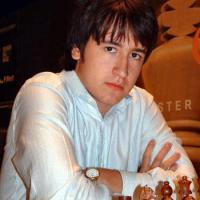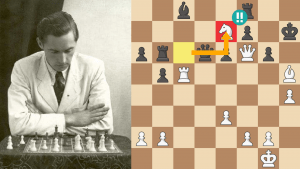
The Jaenisch/Schliemann Gambit
Farbror asked:
This is one of my favorite chess quotes:
“Before our first Latvian posting I didn’t care for this gambit one way or the other. Now I hate it with a passion and, when I hit my 80th birthday, fully intend to devote my remaining years in finding one final, catastrophic refutation to this blight on humanity (hopefully someone will beat me to the punch).”
There cannot be too much passion in chess!
Anyhow, suppose I want to play active after 1.e4 e5 2.Nf3 and would like to stand on more solid ground than “I Like!” What should I look for? The Latvian and the Elephant gambit feel a bit too wild but is the Schliemann gambit (Jaenisch gambit) much better?
Dear Mr. Farbror:
Yes, I did write that several years ago, but it was all in jest. I honestly don’t hate any opening (though I do think quite a few are bad, which I freely say when a chance happens by), and I would hope that, rather than staring at chess moves and thinking of opening vengeance, I’ll spend my time after 80 in the company of dozens of lovely young women or, if my decaying body is no longer a chick magnet, then in some Buddhist monastery in lands far, far away.
I think the Jaenisch/Schliemann Gambit (C63 – 1.e4 e5 2.Nf3 Nc6 3.Bb5 f5!?) is a very interesting system! This anti-Lopez line was first played and explored by the Finnish player Carl Jaenisch around 1847. However, the German player Adolf Schliemann adopted it later and, for some reason, many people named it after him! Oddly, both players died in 1872.
Over the years, I’ve seen refutations to the Jaenisch/Schliemann come and go, but when Radjabov successfully took it up, the opening finally acquired a measure of respectability! Indeed, now it’s occasionally used by giants like Radjabov, Ivan Sokolov, Aronian, Zvjaginsev, Khalifman, Ivanchuk, and even Magnus Carlsen (against Anand)!
In general, White has two good ways to deal with the thing. One is 4.Nc3, which leads to serious complications and loads of theory, while not promising White more than a microscopic edge. The other is 4.d3, a quiet positional line that takes a lot of the fun out of the Jaenisch/Schliemann – it’s still quite playable for Black, but he tends to be on the “struggle” side of a draw.
FUN LINES FOR BLACK
1.e4 e5 2.Nf3 Nc6 3.Bb5 f5 4.exf5
Also harmless is 4.Bxc6 dxc6 5.Nc3 Nf6 6.Qe2 Bc5 7.exf5 Qe7 8.d3 Bxf5 9.0-0 0-0 10.Qxe5 Qxe5 11.Nxe5 Rae8 12.Nc4 Ng4 13.Be3 Nxe3 14.Nxe3 Bxe3 15.fxe3 Rxe3 16.Ne4 Bg4 17.h3 Bh5 18.Rxf8+ Kxf8 19.Rc1 Ke7 20.Kf2 Re2+ 21.Kf1 Re3 22.Kf2 Re2+ 23.Kf1 Re3 ½-½, M. Pavlovic (2533) - Iv. Sokolov, (2657), Kragujevac 2009.
4…Bc5!?
4...e4 5.Qe2 Qe7 is another good way to handle the position.
5.Bxc6 dxc6 6.Nxe5 Bxf5 7.Qh5+
White thought he was onto something, but the legendary Chigorin demonstrates that all is not what it appears to be.
7...g6 8.Nxg6? hxg6!
And not 8...Bxg6? 9.Qxc5.
9.Qxh8 Qe7+ 10.Kd1
10.Kf1 Bxc2 (simply 10...0-0-0 is very strong too) 11.Qxg8+ Kd7 12.Qc4 (12.Qxa8 Bd3+ 13.Kg1 Qe1 mate) 12...Re8 13.g3 Qe1+ 14.Kg2 Qxf2+ also wins quickly for Black. Analysis by Paul Motwani.
10...Bxf2! 11.Qxg8+ Kd7 12.Qc4
12.Qxa8 Bg4 mate.
12...Re8, 0-1, E. Schiffers - M. Chigorin, St Petersburg 1878. Though white’s a Rook ahead, the horrific threat of 13…Qe1+ leaves White unable to muster a defense. Motwani gives the following: 13.d4 (13.d3 Qe2) 13...Bg4+ 14.Kd2 Qe3 mate, 0-1.
MAIN LINE
1.e4 e5 2.Nf3 Nc6 3.Bb5 f5 4.Nc3 fxe4
4…Nd4!? (the Bulgarian Variation) might also be playable.
5.Nxe4 is the main line of the Schliemann. Black can meet it in two ways: 1) 5…Nf6 and 2) 5…d5.
1) 5…Nf6!?
Known as the Tartakower Variation, this has become rather popular. White now has 1.a) 6.Qe2 and 1.b) 6.Nxf6+.
1.a) 6.Qe2 d5 7.Nxf6+ gxf6 8.d4 Bg7 9.dxe5
Harmless is 9.c4 Bg4 10.cxd5 Qxd5 11.dxe5 0–0–0 and Black had an excellent position in A.Morozevich - L. Aronian, Amber Rapid 2006.
9…0–0 10.Bxc6
The alternative is 10.e6 Ne5 (10…Re8 11.0–0 Rxe6 12.Qd3 a5) 11.0–0 (11.Bf4 Qd6 12.0–0 Bxe6 13.Nd4 Bd7 14.Bxd7 Qxd7 15.Qh5 Ng6 16.Bh6 Bxh6 17.Qxh6 c5 18.Nf3 Qg4 19.h3 Qf5 20.Rad1 Rae8 21.c3 Re4 22.Rfe1 Rfe8 23.Rxe4 Rxe4 24.Nh2 Qe6 25.Ng4 f5 26.Rxd5 fxg4 27.Rd8+ Kf7 28.Qxh7+ Kf6 29.Rd7 gxh3 30.Qg7+ Kg5 31.Rd3 hxg2 32.Rg3+ Rg4 33.f4+ Kxf4 34.Qc7+ Qe5, K. Haznedaroglu (2468) - J. Werle (2575) Rethymno 2009) 11…c6 (11…Bxe6 was J. Polgar - T. Radjabov, Wijk aan Zee 2008: 12.Nd4 Bg4 13.f3 Bc8 [13…Bd7 is also playable] 14.f4 c6 15.fxe5 fxe5 16.Rxf8+ Qxf8 17.Bd3 e4! 18.Bxe4! Bxd4+ 19.Be3 Bxe3+ 20.Qxe3 dxe4 21.Qg5+ Qg7 22.Qd8+ Qf8 23.Qg5+, 1/2-1/2) 12.Bd3 Bxe6 13.Nd4 Bg4 14.f3 Bd7 15.f4 (15.Nf5 Nxd3 16.Qxd3 Qb6+ 17.Kh1 Bxf5 18.Qxf5 Rae8 was nice for Black in Renet - M. Tseitlin, Palma de Mallorca 1989; 15.Bf5 Re8 [15…c5] 16.f4 Qb6 17.Qf2 Bxf5 18.Nxf5 Ng4 19.Qxb6 axb6 20.h3 Nh6, =+, V.Varavin - Kulikov, Tula 2000) 15…Nxd3 16.Qxd3 Qe8 (16…Re8 17.Be3 Re4, =) 17.Bd2 Qe4 18.Qxe4 dxe4 19.f5 c5 20.Ne2, A. Shirov – Y. Gozzoli, Grenke Rapid W Ch 2010, and now 20…Rad8 is =.
10…bxc6 11.e6 Re8 12 0–0 Rxe6
It’s white’s superior pawn structure vs. black’s two Bs.
13.Be3
13.Qd3 a5 14.Re1 Rxe1+ 15.Nxe1 c5 16.Bf4 c4 17.Qd4 Be6 18.Nf3 Bf8 19.Qe3 Bf7 20.Nd4 c5 21.Ne6 Qb6 22.Nxf8 Rxf8 23.Re1 Bg6 24.Qg3 Qc6 25.h4 Kf7 26.Bd6 Re8 27.Rxe8 Qxe8 28.Bxc5 Qe1+ 29.Kh2 Qe5 30.c3 a4 31.Bd4 Qxg3+ with an eventual draw, Perez Candelario (2513) - M. Adams (2703) Zafra 2009.
13…Re8!?
Freeing the c8-h3 diagonal. Other moves like 13…c5 and 13…d4 have also turned out well for Black. After 13...d4 the game Van den Doel - Snuverink, Leeuwarden 2003 continued 14.Rfd1 (14. Nxd4?? Qxd4) 14…c5 15.c3 Ba6 16.Qd2 d3 17.Bxc5 Re2 and Black had a very nice game.
14.Qd3 Bg4
14…Qd6!? - Kosten
15.Nh4
15.Bc5!? stops black’s pawns in their tracks.
15…c5! 16.Rfe1
16.Bxc5!? Be2 17.Qh3 Bxf1 18.Rxf1 was mentioned by Kosten.
16…c4 17.Qd2 f5
17…Qd6!? might be best.
18.Bg5
18.h3 Qxh4 19.Qxd5+ Kh8 20.hxg4 Qxg4 21.c3 – Kosten.
18…Qd7 19.c3 d4 20.h3 Bh5 21.Bh6 Bf6 22.Bg5 Bh8 23.Be7
Tricky - Kosten said that 23.cxd4 Qxd4 24.Qa5 was stronger.
23…Bg6 24.Bc5 d3 25.Nf3 Re4 26.Ng5 Rxe1+ 27.Rxe1 Bf6 28.Qf4 Qd5 29.Bd4 Bxd4 30.cxd4 Qd6 31.Qh4 Rf8
31…Rb8! was stronger.
32.Nf3 f4 33.Qg4 Qf6 34.Qd7 Qd6 35.Qb5 Bf7 36.b3 c6 37.Qg5+ Qg6 38.Qxg6+ hxg6 39.bxc4 Bxc4 40.Ne5 Bb5 41.a4 Bxa4 42.Nxd3 Bb5 43.Ne5 Kg7 44.Nd7 Rf7 45.Nc5 a5 46.f3 a4 47.Kf2 a3 48.Ra1 Ra7 49.Ne6+ Kf6 50.Nxf4 Bc4 51.Ne2 a2 and 0-1 (the last part of the game was a maniacal time scramble.), A. Shirov - T. Radjabov, Odessa 2007.
1.b) 6.Nxf6+
Olivier Renet claims that this is the only way to “set real problems for Black.”
6…Qxf6 7.Qe2 Be7 8.Bxc6 dxc6 9.Nxe5 Bf5 10.0–0
Black’s two Bishops and activity give him compensation, but is it enough?
10…0-0 11.d4 Bd6
The viability of this line rests on the possibility of creating opposite color Bishops (by capturing white’s Knight with black’s dark-squared Bishop), which will often allow Black to draw an endgame even if he’s a pawn down.
12.c3
12.Bd2 Kh8 13.c4 (13.Bc3!?) 13...Bxe5 14.Qxe5 Qf7 15.Qg3 (15.b3 Bd3; 15.Rfe1 Bd3 16.Qg3 Bxc4) 15...Rad8 16.Bc3 Qxc4 17.d5 Rd7, ½-½, Navarrete Delgado (2242) - C. Vitoux (2423), Condom 2009.
12...Be6
12...Rae8 13.f4 c5 14.Be3 cxd4 15.cxd4 Qe6 16.Qf3 c6 17.Rf2 Qd5 18.Qxd5+ cxd5 19.Rc1 Rc8 20.Rff1 a6 21.Rxc8 Rxc8 22.Rc1 Rxc1+ 23.Bxc1 Bxe5 24.dxe5 d4 25.b4, ½-½, I. Gaponenko (2468) - Y. Gozzoli (2502), La Fere 2008.
13.f4 Rae8 14.Be3 Qf5 15.b3 a5 16.Rae1 a4 17.c4 axb3 18.axb3 h5 19.h3 Qh7 20.g4 hxg4 21.hxg4 Bxe5 22.dxe5 Qg6 23.Rf2 Qxg4+ 24.Qxg4 Bxg4 25.Ra2 Kf7 26.Ra7 Bc8 27.Kf2 Rh8 28.Rg1 g6 29.b4 Rd8 30.b5 cxb5 31.cxb5 Rh2+ 32.Rg2 Rxg2+ 33.Kxg2 Be6 34.Kf2 Bd5 35.b6 cxb6 36.Bxb6 Rc8 37.Ra5 Ke6 38.Bc5 Rc6 39.Rb5 Kf5 40.Bd6 Rc2+ 41.Ke3 Bc6 42.Ra5 Rc4 43.Ra8 Re4+ 44.Kd3 Rxf4 45.Rf8+ Kg4 46.Rxf4+ Kxf4 47.e6+ Kf3 48.e7 g5 49.Kd2 g4 50.Ke1 Bb5 51.Bc7 g3 52.Bb6 Kg2 53.Bc7 Be8 54.Bd6 Bh5 55.Bc7 Bf7 56.Bd6 Be8 57.Bc7 b5 58.Bd6 Bh5 59.Be5 Kh3 60.Kf1 b4 61.Kg1 b3 62.Bb2 Be8 63.Bc3 Bc6 64.Bb2 Kg4 65.Bc3 Kf3 66.Bb2 Ke2 67.e8=Q+ Bxe8 68.Kg2, ½-½, V. Kramnik (2766) - T. Radjabov (2729), Amber Rapid G/25 +10, 2007.
2) 5…d5 6.Nxe5
6.Ng3 Bg4 (intending ...Qd6 followed by ...0-0-0) 7.h3 Bxf3 8.Qxf3 Nf6 and black’s fine.
6…dxe4 7.Nxc6 Qg5
7…Qd5 doesn’t have a very good reputation, though the analysis to prove it is long and very complex.
8.Qe2 Nf6 9.f4 Qxf4 10.d4
10.Nxa7+ Bd7 11.Bxd7+ Kxd7 12.Qb5+ Ke6 13.Qxb7 Bd6 leaves Black with a huge lead in development, which compensates his oddly placed King and material deficit. The game A. Rusak - J. Simmelink, Email 1999 continued 14.Qb3+ Kd7 15.Qf7+ Be7 16.Nc6 Kxc6 17.Qxe7 Rae8 18.Qa3 Rhf8 19.Qa6+ Kd7 20.g3 Qf3 21.Rf1 Ng4! 22.Qc4 Nxh2 23.Rxf3 exf3+ 24.Kf2 h5 25.Qd5+ drawn by perpetual check. Exciting!
10…Qh4+ 11.g3 Qh3 12.Ne5+ c6 13.Bc4 Be6 14.Bg5
White is thought to be slight better due to his superior pawn structure and his huge Knight on e5, but Black has shown that he is surprisingly solid.
14.Bf4 is an important alternative, but is most likely no better than 14.Bg5.
14…0–0–0 15.0–0–0 Bd6 16.Rhf1
Other choices have also failed to dent black’s position:
* 16.Nf7 Bxf7 17.Bxf7 Rhf8 18.Bc4 Rde8 19.Rhg1 h6 20.Bf4 with nothing more than a tiny plus for White.
* 16.Qf1 Rhe8 17.Qxh3 Bxh3 18.Nf7 Rd7 19.Bxf6 gxf6 20.Nxd6+ Rxd6 21.Rhe1 f5, =, P. Prohaszka (2336) - A. Murariu (2441), Budapest 2005.
16…Rhe8 17.Bxf6 gxf6 18.Rxf6 Bxe5 19.Rxe6 Rxe6 20.Bxe6+ Qxe6 21.dxe5 Qh6+ 22.Rd2 Rxd2 23.Qxd2 e3 24.Qe2 Qg5 25.Kd1 Kc7 26.Qd3 Qh5+ 27.Kc1 Qh6 28.Kd1 Qh5+ 29.Ke1 Qxh2 30.Qd6+ Kc8 31.Qf8+ Kc7 32.Qe7+ Kc8, 1/2-1/2, M. Carlsen - LD Nisipeanu, King’s Tournament 2010.
THE POSITIONAL APPROACH via 4.d3
1.e4 e5 2.Nf3 Nc6 3.Bb5 f5 4.d3 fxe4 5.dxe4 Nf6 6.0-0
6.Bg5 Bc5 7.Nc3 d6 8.Bxf6 Qxf6 9.Nd5 Qd8 10.b4 Bb6 11.0-0 Bg4 12.a4 0-0 13.Be2 Bxf3 14.Bxf3 a6 15.Nxb6 cxb6 16.c3 Kh8 17.Bg4 Rf6 18.Qd3 Ne7 19.g3 Qc7 20.a5 Raf8 21.Qe3 bxa5 22.Rxa5 Qc4 23.h4 Qc6 24.Be2 Rc8 25.Ra3 Rcf8 26.Kg2 d5 27.f3 Qc7 28.Bd3 Rd6 29.Rf2 d4 30.cxd4, ½-½, V. Ivanchuk (2779) - T. Radjabov (2761), Linares, 2009.
6…Bc5 7.Qd3
7.Bxc6 bxc6 8.Nxe5 0–0 9.Bg5 Qe8 10.Bxf6 Rxf6 11.Nd3 Bd4 12.c3 Bb6 13.Nd2 was B. Macieja - T. Radjabov, Russia 2007, where Black tries to show that his two Bishops compensate for white’s extra pawn. This is still all theory, and the game continued 13…d6 (13…Ba6 has also been tried; 13…d5!? has been suggested by Kosten, who gives 14.exd5 Bh3 15.gxh3 Qg6+ 16.Kh1 Qxd3) 14.c4 (14.Qe2 was played in Bruzon - Gomez, Santa Clara 2000: 14…Ba6 15.c4 Qf7 16.b3 Re8 and black’s okay) 14…Rh6 (Radjabov tried 14...Qg6 but got into some trouble and eventually lost) 15.Re1 (15.c5 Bxc5 16.Nxc5 Qe5 17.h3 Qxc5 is nothing for White) 15…Qe7 16.Nf1 Qg5 17.Qd2 Qh5 18.Rac1 Bd4 19.Nb4 Be5 with mutual chances in N. Aginian - Shukurova, Elista 1998.
7…d6 8.Qc4 Qe7
8…Bd7 9.Bxc6 Bxc6 10.Nxe5 Bxf2+ 11.Rxf2 dxe5 12.Nc3 Qe7 13.Be3 Qf7 14.Qxf7+ Kxf7 15.Nd5 Bxd5 16.exd5 b5 17.c4 bxc4 18.Rc1 Rhd8 19.Rxc4 Kg8 20.Bg5 Rxd5 21.h3 Rf8 22.Rfc2 Rd1+ 23.Kh2 Nd5 24.Re2 h6 25.Be3 a6 26.Re4 Nxe3 27.R4xe3 Re8 28.Rxe5 Rxe5 29.Rxe5 Rd2 30.Ra5 Rxb2, ½-½, I. Karim (2288) - V. Inkiov (2523) Paris 2006.
9.Be3
9.Nc3 Bd7 10.Nd5 Nxd5 11.exd5 Nd4 and though white’s somewhat better, Black managed to hold the draw in M. Carlsen - T. Radjabov, Linares 2008.
9…Be6 10.Qa4 Bd7 11.Bxc5 dxc5 12.Nc3 Nd4 13.Bxd7+ Nxd7 14.Nxd4 cxd4 15.Nb5 Qc5 16.c3 a6 17.Na3 0-0-0 18.Rac1 d3 19.b4 Qb6 20.Nc4 Qe6 21.Qb3 Nf6 22.Rce1 Rhe8 23.Nd2 Qb6 24.Nc4 Qc6 25.Nd2 Nh5 26.g3 Qh6 27.Qd1 Nf6 28.a4 Qh3 29.f3 Nh5 30.Rf2 Re6 31.Nf1 Rg6 32.Qd2 Nf4 33.Rd1 Rdd6 34.Kh1 Ne2 35.Rg2 h5 36.Qe3 Kb8 37.a5 Qd7 38.c4 Rd4 39.Qd2 h4 40.g4 Qf7, 0-1, Al Modiahki (2585) - Tu Hoang Thong (2506), 8th Asian Continental Open, 2009.






